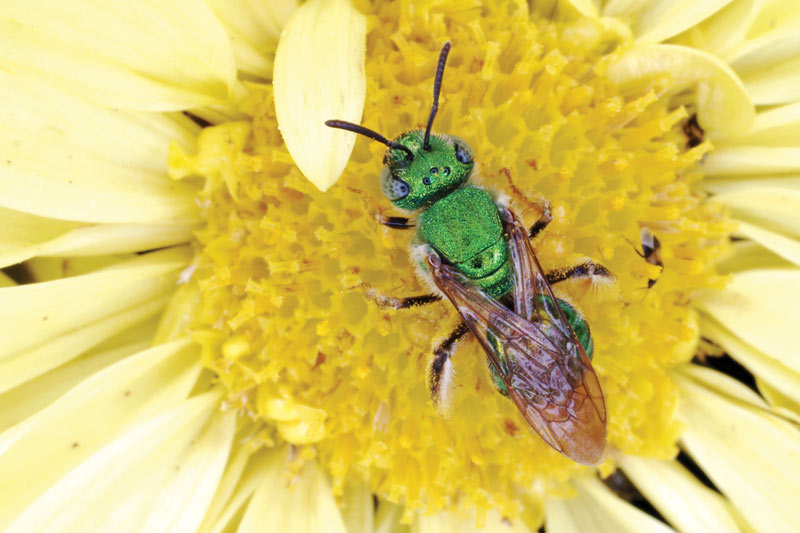
Golf courses can contribute to healthy populations of bees, butterflies and other pollinating insects by adding appropriate habitat in out-of-play areas. Photo by Jim Kalisch
U.S. turfgrass entomologists gathered in Sheboygan, Wis., in 2016 to discuss a host of issues surrounding insects in turfgrass, but their focus was on the plight of insect pollinators, including — but not limited to — honey bees, bumble bees, pollen wasps, ants, flies, hover flies, mosquitoes, butterflies, moths and flower beetles.
Pollinating insects are vital to the planet’s survival. Some pollination is carried out by wind and plants, but approximately 90 percent of the world’s crop plants require animal pollination to reproduce. Pollinators have experienced significant population decline since the end of the 20th century, and various theories have been posited for the decrease in their numbers, including habitat loss, parasites, disease stresses to social bee colonies, and exposure to pesticides.
As scientists concerned with the health of both the turf and the pollinators, the group that met in Wisconsin put together a new guide: “Optimizing pest management practices to conserve pollinators in turf landscapes: Current practices and future research needs,” which was published online last summer as an open-access document in the Journal of Integrated Pest Management.
The article describes best management practices (BMPs) for controlling pests in turf while protecting pollinators from insecticide exposure; alternatives to insecticide use; ways to create pollinator conservation habitats, particularly on golf courses and especially for bees and the monarch butterfly; and the role of lawns in pollinator conservation. A large section of the document underscores the need for more research to improve pollinator survival and efficacy.
Jonathan Larson, Ph.D., Extension entomology educator at the University of Nebraska-Lincoln and lead author of the journal article, says, “Our goal is to ensure that managers can do their work and provide the kind of turf their clients demand, (with) minimal impact on the environment. Healthy turf and healthy pollinators do not have to be mutually exclusive ideas.”
Some of the BMPs for integrating chemical controls in turf are:
- Mow flower heads of weeds (for example, clover, dandelion and bird’s-foot trefoil) before insecticide treatment.
- Wait until May or June, after the peak bloom of most weeds, to apply turf insecticides to avoid pollinator exposure.
- Avoid treating during peak pollinator foraging periods; restrict insecticide applications when winds are greater than 5 to 6 mph.
- Use granular rather than liquid forms of neonicotinoids.
- Use a different chemistry class: for example, chlorantraniliprole (anthranilic diamide) instead of clothianidin (neonicotinoid).
- Irrigate to remove insecticide residues from pollinator foraging areas.
Turf managers should also consider employing cultural and biological controls to regulate pests. Some options include mowing and collecting clippings to remove insect eggs, and selecting turfgrasses with endophytes that promote pest resistance and tolerance of drought and environmental stresses. Strategies such as proper irrigation timing, fertility management, higher mowing heights, and hollow-tine cultivation can also reduce pest insect density and mask damage.
Numerous golf courses have established successful pollinator habitats for bees and monarch butterflies that are attractive and enhance the golf experience. Several initiatives — such as those from the Audubon Cooperative Sanctuary Program and the USGA, and Syngenta’s Operation Pollinator — have demonstrated how pollinator habitat can be integrated into the golf course landscape. Superintendents seeking advice on plants for their specific locations should contact their local Extension office, or consult the Xerces Society or the Pollinator Partnership.
As Larson points out, “New research ... will help to bolster best management practices and ensure that managers are on the cutting edge of sustainable efforts.” The document developed by the turfgrass entomologists defines multiple areas of concern — particularly the effects of pesticides — that must be addressed by scientists in academia and in industry. The risk to pollinators from pesticide applications must be understood so that safer management practices can be developed, but solving this problem won’t be possible without the establishment of scientific measures of pollinator health. The unforeseen effects of insecticides, such as potential suppression of honey bee immune systems, must be investigated, along with the movement, uptake and persistence of systemic insecticides and fungicides in plants like flowering weeds. Drift from spray applications of pesticides and the subsequent persistence of the insecticides on plants is another area that warrants study. Ultimately, the goal is plentiful pollinators and healthy turf, flowers and crops.
Access the full article in the Journal of Integrated Pest Management.
Teresa Carson is GCM’s science editor.